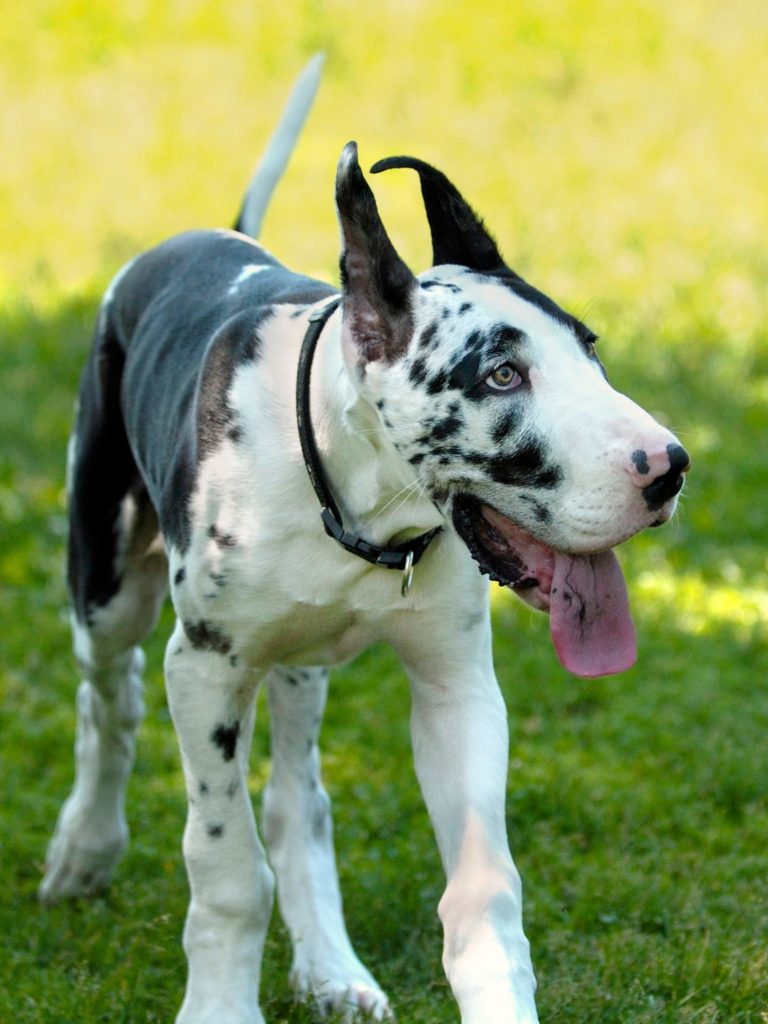Bark Busters, Sit Means Sit and Off-Leash K-9 are three of the most popular franchise dog training companies in the U.S.
If you are searching for more information about dog training for your Great Dane, and considering hiring one of these companies or sending your dog to them for a board and train, read on for more!
FRANCHISE DOG TRAINING
A franchise is essentially a ‘child’ business to a parent company. All three companies we are talking about today run on a franchise model.
Anybody with the financial means can purchase a franchise. They do not necessarily have to have dog training experience!
In purchasing the franchise, however, they do have to follow the parent companies marketing, location and training methods and ideaology.
Franchise dog trainers have access to the larger company, which means better/nicer websites, better reach in search engines, and a polished, shiny, engaging sales pitch.
This can make a dog trainer/franchise owner look infinitely more polished, experienced and successful than they actually are.
Great for business, but not so great for you and your dog. Upon approval and financing, a new franchise dog training company owner will typically take a roughly 2-week long ‘intensive’ course, from which they emerge as a ‘dog trainer’ for the company.
2 weeks. That may be all the experience they have.
FINDING EMPLOYEES
If you do a search through your local job ads, you may notice that any one of these companies may be hiring.
In my experience, they typically look for people with very little dog training experience.
“We will train you!” As a matter of fact, these companies may purposefully seek trainers with little or no experience so they can fully sell them on the method they use.
With time, these trainers do gain experience…however, their experience will be limited to the methodology and ideology of the franchise parent company.
Remember, franchise dog training companies have marketing experts, lawyers and social media teams in place to make these businesses look like the best option available, especially to desperate and frustrated dog owners!
A team of marketing and media experts is on hand to bury bad reviews and push all ‘positive’ results to the top, so all you see is good stuff.
BARK BUSTERS DOG TRAINING FOR GREAT DANES
Bark Busters, as of this writing, uses a methodology based in extremely outdated ideas about being the ‘pack leader’.
Note: Canine behavioral science considers ‘alpha’ theory, ‘dominance’ and ‘pack leader’ ideologies to be a load of nonsense. It’s woo woo in the world of dog training.
To market their business, they use words such as ‘humane, dog friendly methods’, ‘lasting emotional bond’, ‘natural techniques’.
Bark Busters does not use e-collar, shock collar, clickers, ‘harsh treatment’ or treats. They believe that body language and voice are all that is needed, and that all behavior problems from aggression to crying in the crate are resolved very simply when you implement order and hierarchy.
Despite their claim that they don’t use harsh methods or need anything more than voice control and body presence, Bark Busters training tools DO include the following: air horns, penny cans, bean bags full of chains, shouting a gutteral ‘BAH’ at the dog and spray bottles.
Like the other franchise dog training models, they are not very transparent about their methods, beyond claims that they can ‘quickly and easily’ fix all behavior problems. They often say that they can transform even the most out of control dog within an hour.
While being a good leader and providing enrichment and structure may be important, it’s not the entire story when it comes to dog training. Anybody can throw a bag of pennies near a dog and frighten them into ‘submission’, but that’s not dog training, nor is it natural. It’s intimidation.
THE SHINY SALES PITCH
There is no such thing as a quick fix, or quick dog training.
There are things you can do to manage the environment, teach, guide and help your dog learn. These things take time & dedication.
Dogs, like humans, take time to grow their skills into advanced levels.
Be very, very wary of the shiny sales pitch, implying that a dog can be made free of aggression, fear or poor behavior with just a few training sessions or two weeks in a board and train program.
You owe it to your dog to choose an experienced dog trainer that understands canine behavior and modern, up to date scientific methodology in dog training.

SIT MEANS SIT DOG TRAINING FOR GREAT DANES
Sit Means Sit has the ultimate shiny sales pitch, using words such as ‘cutting edge’ and ‘attention based’ training. As with all franchise training companies, they have large facilities, huge websites and lots of online presence, which can lead people to believe that they are the real deal.
Sit Means Sit is the franchise model of ‘compulsion-balanced’ dog training, where trainers will use anything at everything at their disposal to train a dog (leash, muzzle, crate, e-collar, prong, penny can, etc.).
While there isn’t much inherently wrong with taking a proper, thoughtful and humane balanced approach to dog training (Larry Krohn is a good example of proper balanced training), it’s important to note that balanced dog training is no longer balanced if the primary method of teaching is punishment.
Sit Means Sit uses e-collars for training. At Hello Danes, we believe in and recommend properly used E-Collars.
They recommend the brand that they produce and sell, despite the fact that there are many quality options in the world of e-collars. E-collars can be a wonderful tool when used correctly.
Positive reinforcement and management must still be used, and it’s unclear if Sit Means Sit trainers consistently use treats, praise or play to reward correct behaviors, and if they are able to teach a dog basic Kindergarten level obedience skills (sit, go to a mat, stay) without the use of the e-collar.
A quick search of some video training on Youtube produced Sit Means Sit training and dogs that look uncomfortable and disengaged. They ‘pay attention’ because the tap from the e-collar asks them to, but they aren’t necessarily paying attention because they are engaged with the handler and excited to learn.
They are panting, turning their head away, walking low to the ground and trying to avoid the training.
That to me is a HUGE red flag that they are inappropriately using e-collars and ‘balanced’ training methods.

DOG BODY LANGUAGE
Dog training should NEVER make a dog feel frustrated, scared, confused or intimidated.
As a matter of fact, good dog training is about resolving feelings of insecurity, anxiety, fear, confusion and frustration!
When evaluating potential dog trainers, watch them in action on their videos, social media or by attending a class to observe.
The dogs should have positive body language, be engaged with the handler and trainer, and happy to be learning. The dog in the photo on the left does NOT have positive body language!
Here are some signs that a dog is uncomfortable, anxious, stressed, confused, frustrated or checked out:
Ears pinned back, overall tense body, tight tail wags, tucked tail, stiff tail, stiff mouth, hunched shoulders and body, walking low to the ground, grimace, panting, cowering, hiding, shaking, or pulling to get away.
Avoidance signals may include sniffing, scratching, sneezing or turning the head or body away from the handler.
Sometimes a dog will do these to ‘think’, but they should come back on their own and re-engage.
Do not mistake ‘calm submission’ with ‘well trained’ or ‘confident/happy’. Dogs being presented in a ‘calm submissive’ state are often very stressed and checked out.
Work with a quality, experienced trainer that understands body language and that uses modern, humane and thoughtful training methods.

OFF LEASH K-9 DOG TRAINING FOR GREAT DANES
Off Leash K-9 loves to use social media and youtube to astound viewers with videos of dogs that after just a few short training sessions can walk off-leash through busy locations.
It’s easy to be amazed by this, but find me one of these videos where:
a. The dog is comfortable, excited and engaged with this activity and has loose, calm, confident body language (no panting, grimace, stiffness or wide eyes).
b. The dog needs to be doing this activity for some reason.
c. The dog is doing this activity in an area where it’s legal and safe to be off-leash. (Note, even highly trained service dogs must remain on a leash in busy areas!).
Go ahead, I’ll wait.
Off Leash K-9 claims they can take your dog for a board and train and have it fully trained within 2 weeks. They may use some toys and praise to reward dogs, but rarely treats or food motivators,. They use the e-collar and prong tools to communicate.
Note, it is very easy to keep a dog in a down-stay for 3 hours at a time (or in a strict heel through a busy area) if it is both extremely worn out (following treadmills and structured walks) and then corrected (collar pop, e-collar correction, verbal correction etc.) every time it tries to step off of an elevated bed or break the heel position.
Off Leash K-9 relies on this principle, calling it ‘discipline’. In the four quadrants of operant conditioning, this is called ‘positive punishment’.
Small corrections may be appropriate and may come into play depending on the trainer, but as above it’s not ‘balanced’ training if reliance is made primarily on corrections.
The Off-Leash K-9 model claims to be able to fully, reliably train any dog quickly. That’s not how humane, thoughtful and ethical dog training works, so be cautious about this shiny sales pitch.
FRANCHISE BOARD AND TRAIN RED FLAG
Many franchise dog trainers have been sued or shut down because of abuse. Videos abound of dog trainers harshly punishing dogs, bonking them with objects, scaring them or using high-level stims to keep the dog in place.
Worse, there are 100’s of reports of dogs coming back from board and train with behavioral and health problems. They may be emaciated, dehydrated or even terrified.
Some dogs have even passed away while in board and train. Remember, board and train franchise owners and their employees may actually have little to no dog or training experience.
A board and train program may be a great way to install the basics and reinforce known skills in a new environment, but we encourage you to look beyond franchise training companies when pursuing that option.

THE BIG PICTURE
There are better, more reliably qualified dog trainers out there that aren’t required to utilize a canned franchise method to teach your dog.
We encourage you to be wary of any trainer that will ‘method bash’ between ‘positive’ and ‘balanced’ or claim to provide ‘quick results’ through the use of ‘psychology’ and ‘woo’.
Good dog training relies on creating a positive relationship with your dog, based on trust and guidance. Even when E-Collars are involved!
Being ‘old school’ or stuck in a franchise ‘quick fix’ model as a dog trainer is not a good thing; many of the world’s top obedience, agility and scent tracking dogs were not trained through alpha rolls, so why does your pet dog need to be trained that way?






